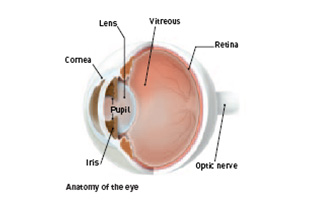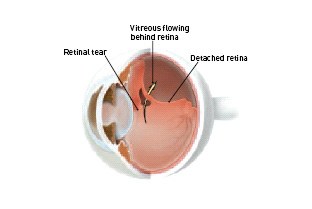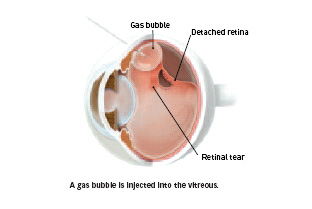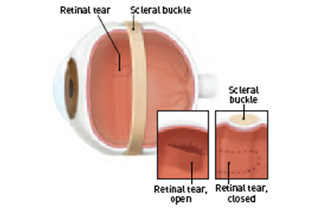A retinal detachment is a very serious problem that usually causes blindness unless treated. The appearance of flashing lights, floating objects, or a gray curtain moving across the field of vision are all indications of a retinal detachment. If any of these occur, see an Advanced Eye Center ophthalmologist right away.

As one gets older, the vitreous (the clear, gel-like substance that fills the inside of the eye) tends to shrink slightly and take on a more watery consistency. Sometimes as the vitreous shrinks, it exerts enough force on the retina to make it tear.
Retinal tears can lead to a retinal detachment. Fluid vitreous, passing through the tear, lifts the retina off the back of the eye like wallpaper peeling off a wall. Laser surgery or cryotherapy (freezing) are often used to seal retinal tears and prevent detachment.

If the retina is detached, it must be reattached before sealing the retinal tear. There are three ways to repair retinal detachments. Pneumatic retinopexy involves injecting a special gas bubble into the eye that pushes on the retina to seal the tear. The scleral buckle procedure requires the fluid to be drained from under the retina before a flexible piece of silicone is sewn on the outer eye wall to give support to the tear while it heals. Vitrectomy surgery removes the vitreous gel from the eye, replacing it with a gas bubble, which is slowly replaced by the body’s fluids.
Pneumatic Retinopexy
A gas bubble is injected into the vitreous space inside the eye. The gas bubble pushes the retinal tear closed against the back wall of the eye.
Your ophthalmologist will ask you to maintain a certain head position for several days. The gas bubble will gradually disappear. Sometimes this procedure can be done in the ophthalmologist’s office.

Scleral Buckle
A flexible band (scleral buckle) is placed around the eye to counteract the force pulling the retina out of place.
The ophthalmologist often drains the fluid under the detached retina, pulling the retina to its normal position against the back wall of the eye. This procedure is performed in an operating room.









